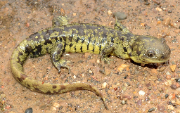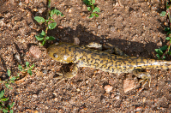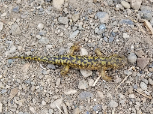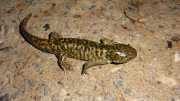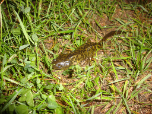Blotched Tiger Salamander (A. m. melanostictum)
Description: The Blotched Tiger Salamander is one of the largest terrestrial salamanders in North America and can grow to over 30 cm in total length, although most individuals are smaller than this. Blotched Tiger Salamanders are very heavy-bodied with broad heads, small eyes, 12 to 14 (usually 13) costal grooves and a laterally compressed tail (especially in males). Young individuals have light yellow or cream-coloured blotches or bars on a dark background but this colouration switches as individuals age, with the light colour becoming the background and the dark colours being reduced to bars and blotches. The belly is dark grey. Neotenic individuals (see biology) tend to attain larger sizes than terrestrial adults. Aquatic larvae are generally olive to greenish yellow with legs (both front and back), a tail fin and feathery gills that are longer than the head
Habitat: Blotched Tiger Salamanders breed in permanent or semi-permanent lakes, ponds or wetlands that are fish-free. They inhabit a variety of terrestrial habitats within close proximity to these breeding sites, including forest, parkland, grassland, sub-alpine meadows and semi-desert. Loose or sandy soil that the salamanders can burrow into, cover objects (rocks, woody debris) and small mammal burrows are important microhabitat features that provide shelter. Individuals overwinter underground below the frost line in burrows they excavate or in mammal burrows.
Range: Western Tiger Salamander: A wide distribution through most of the western half of the US, only occasionally in California and Nevada. It extends from the southernmost tip of Texas up to Canada. The range has a broad north-south distribution but extends no further east than the Dakotas and Oklahoma. Populations have been introduced into southern Arizona through the human use of larvae as fish bait.
Diet: Tiger Salamanders are opportunistic predators and eat a wide variety of insects, spiders, worms and other terrestrial invertebrates, as well as small vertebrates such as mice. Larvae prey on aquatic invertebrates, larval frogs and salamander larvae, including other Tiger Salamander larvae.
Reproduction: Blotched Tiger Salamanders migrate to breeding wetlands on rainy nights in the early spring just after the ice cover recedes from the breeding habitats. After breeding, females attach eggs singly or in small clusters to submerged sticks or other vegetation at least 30 cm below the surface of the water. The number of eggs that each female lays depends on geographic location and female body size, but can range from 100 to 5000. The eggs hatch into aquatic larvae after two to three weeks, and the larvae transform into terrestrial juveniles in late summer. Some individuals retain larval features as adults and remain aquatic their entire life (neoteny). Males usually reach sexual maturity in two years, while females may not reach maturity until they are three to five years old. Females may only breed every two years. Tiger Salamanders are long-lived, and individuals may live over 25 years. After the breeding season, adults spend most of their time in underground burrows and cavities, making them difficult to find during the summer and fall
Status: Listed as Least Concern in view of the large extent of occurrence, large number of subpopulations and localities, large population size and use of a wide range of habitats.
»» Kingdom: Animalia - Animals
»» Phylum: Chordata - Chordates
»» Subphylum: Vertebrata - Vertebrates
»» Class: Amphibia - (Amphibians)
»» Order: Caudata - Salamanders
»» Family: Salamandridae - Newts
»» Subfamily: Pleurodelinae - Pleurodeline Newts
»» Genus: Ambystoma
»» Species: Ambystoma mavortium - Western Tiger Salamander
»» Subspecies: A. m. melanostictum - Blotched Tiger Salamander
This article uses material from the Wikipedia article "Barred Tiger Salamander", which is released under the Creative Commons Attribution-Share-Alike License 3.0. Content may have been omitted from the original, but no content has been changed or extended.
|





